History
The origins of the DB-8A goes back to the Northrop Gamma.
It was the Northrop Gamma C-2, developed as an attack plane. This aircraft was slightly modified as Gamma 2F and ordered by the USAAC under the designation A-17 and later a second series with retractable landing gear was ordered under the designation A-17A.
In August 1937 Northrop was acquired by Douglas. The A-17 was still sold under the name Northrop, however, the export version was sold as Douglas DB-8A.
The DB-8A was also sold to Sweden as DB-8A-1, which had a further 103 aircraft built under license; Argentina as DB-8A-2. Peru as DB-8A-3P, Iraq, the DB-8A-4 and around the DB-8A-5.
Netherlands bought the DB-8A-3N.
| Dimensions: | |||
| Length: | 9,06 m | Wingspan: | 14,05 m |
| Height: | 2,95 m | Wing area: | - m2 |
| Weights: | |||
| Empty weight: | 2390 kg | Max. start weight: | 3580 kg |
| Performances: | |||
| Max. speed: | 416 km/hr | Rate of climb: | - m/min |
| Cruising speed: | 330 km/hr | ||
| Range: | 2000 km | Service ceiling: | 7700 m |
| Miscellaneous: | |||
| Engine type: | One Pratt & Whitney R-1830 S3CG Twin Wasp rated 1050 hp | ||
| Crew: | Two men | ||
| Armament: | Four wing mounted .30 machine guns; one movable .30 machine gun; 1200 pound bombs. | ||
In 1935, plans were made to rebuild the defence and the organization of the LVA was re-examined.
The war organization should consist of three air regiments (LVR = LuchtVaart Regiment), 1LVR for air defence and strategic tasks; 2LvR to support the army and 3 LVR for training. 2 LVR would be composed of four reconnaissance groups, designated as I-2 to IV-2 LVR plus one fighter group, V-2 LVR.
The latter would consist of four divisions, two fighter divisions with one seat fighters and two divisions with two seat fighters.
Besides ordering a number of Fokker-types, there was still need for approximately eighteen fighters to equip one section.
On the market in 1938 there was only the Douglas DB-8A in production, available with three different engines.
There were also the Koolhoven FK-52, Caproni Ca.134 and the Seversky 2 PA available. Of these types there was just only a prototype built.
Fokker and also De Schelde each has two types in development, but these still had to be built.
In October 1938 the Douglas DB-8A in the version with Pratt & Whitney engine was chosen.
After testing a Peruvian unit, On March 14, 1939 a contract was signed to supply 18 aircraft with a Pratt & Whitney R1830 Wasp-SC3G of 1065 hp.
Furthermore, a rotating tub for the observers deemed necessary. The armament, consisting of four FN machine guns would have to be bought by the Netherlands.
Late July the test pilot Coyle made the first flight, which showed that the air intake of NACA cap was inadequate and should be adjusted.
The aircraft, with serial numbers 581 to 599, received LVA registration 381 to 399.
The registrations in the 300 range were assigned to two seat fighters. So the Douglas DB-8A was therefore seen as a fighter.
The 382 and 383 made their test flight in August 1939 and shipped to the Netherlands on August 26, together with the 381.
The 384 to 389 made their test flight in September. Douglas no 386 hit head in the landing and had to go back to the factory for repair.
The 390 to 398 were sent between 8 and 14 November, the repaired 386 finally on 16 November.
The trip lasted about forty days and the first aircraft would be arrived early October and the last aircraft arrived late December in the Netherlands.
After mobilization of the LVA in April 1939, 2-V LVR was not yet operational. It was founded in August and preliminary equipped with seven Fokker D.XVIIs.
In September, two departments formed a 1-V-2 LVR with Fokker D.XXIs and 2-V-2 LVR with Fokker D.XVII.
The DB-8A's would be added to 3-V-2 LVR.
In April 1940 the situation was as follows: 1-V-2 LVR with eight Fokker D.XXIs, 2-V-2 LVR eight Fokker G.Is Wasp, 3-V-2 LVR with twelve Douglas DB-8As and 4-V-2 LVR with eight Fokker G.Is Wasp.
[The Fokker G.Is originated from Spanish order, which could not be delivered due to the arms embargo at that time.
These aircraft became available rather unexpectedly. There was talked about a second order for another 18 Douglas DB-8A]
The DB-8A's were fitted by the LVB Soesterberg.
The commander of 3-V-2 LVR, captain J.A.Bach took care of the testflight and training.
The Commander of the Flight school has requested a number of DB-8As for the training, but this was not allowed.
The alarm on November 7 November 1939 had many movements as a result.
The LVB had to leave air base Soesterberg. To assembly of the DB-8As was to locations such as Maaldrift, Wassenaar and sports park
Ockenburg, near Loosduinen.
This last location was chosen, so the fences and the like were removed and there was a makeshift airport of approximately 200 by 600 m was created.
The DB-8A's which were ready to fly, were flown to Ockenburg and the rest was driven via the road to Ockenburg.
On 11 December it was reported that all eight aircraft, of the first two deliveries, were ready and flown back to Soesterberg.
In early 1940 there were also the last ten aircraft were assembled.
During March 1940 the radios were installed.
However, internal communication was not possible, so the crew communicated with each other through the passing of papers.
On March 15, 1940 Douglas 385 crashed near Ypenburg, as a replacement Douglas 393 came from depot.
Repairs and major maintenance was outsourced and performed by KLM.
On May 10, 1940 was of the Douglas 383 had no spark plugs, eleven Db-8As were further combat ready,to know 381, 382, 384, 385, 387, 388, 389, 390, 391 and 393. During the first hours of the battle, all DB-8A's were disabled.
The cause of this debacle lies in the improper use of the Douglas DB-8A. They were designed as a scout and light bomber, but were deployed here as a two seat fighter, mainly due to lack of appropriate fighter aircraft.
Some aircraft had landed at Ockenburg but there was no possibility to refuel. On may 10, 1940 this field was conquered
by the Germans, but was reconquered.
Ockenburg was not really useful, because it was full with wrecks of Ju-52's.
Finally Douglas 394 to 398 were conquered on Ockenburg, the 397 was heavily damaged.
The 390 was recovered by a scrap metal dealer, who told he was a salver.

[Enclosed photo from BeeldBank NIMH. Click on photo for ordering information]

[Enclosed photo from BeeldBank NIMH. Click on photo for ordering information]

[Enclosed photo from BeeldBank NIMH. Click on photo for ordering information]

[Enclosed photo from BeeldBank NIMH. Click on photo for ordering information]
Factory photos. (All aircraft were delivered with the Dutch roundels.)

[Enclosed photo from BeeldBank NIMH. Click on photo for ordering information]

[Enclosed photo from BeeldBank NIMH. Click on photo for ordering information]

[Enclosed photo from BeeldBank NIMH. Click on photo for ordering information]

[Enclosed photo from BeeldBank NIMH. Click on photo for ordering information]

[Enclosed photo from BeeldBank NIMH. Click on photo for ordering information]

[Enclosed photo from BeeldBank NIMH. Click on photo for ordering information]

[Enclosed photo from BeeldBank NIMH. Click on photo for ordering information]

[Enclosed photo from BeeldBank NIMH. Click on photo for ordering information]
| Serial | Construction nr. | Date in service | Date out of service | Notes |
|---|---|---|---|---|
| 381 | 531 | 20-09-1939 | 10-05-1940 | Shot down near Hoek van Holland. |
| 382 | 532 | 20-09-1939? | 10-05-1940 | Shot down near Honselersdijk |
| 383 | 533 | 20-09-1939 | 14-05-1940 | At Ypenburg without spark plugs. Captured by the Germans. |
| 384 | 534 | 20-09-1939 | 10-05-1940 | Landing at Rozenburg, ended standing on its nose. |
| 385 | 535 | 20-09-1939 | 10-05-1940 | Shot down near Kijkduin |
| 386 | 536 | 29-09-1939 | 15-03-1940 | Crashed while practising dive bombing |
| 387 | 537 | 29-09-1939 | 10-05-1940 | Crashed near Leerbroek, due to wing damage |
| 388 | 538 | 29-09-1939 | 10-05-1940 | Shot down near Voorschoten. |
| 389 | 539 | 29-09-1939 | 14-05-1940 | Landed at Ockenburg because of failure of machine-guns. |
| 390 | 540 | 08-11-1939 (sent from factory) | 14-05-1940 | Because of engine trouble emergency landing near Schipluiden. |
| 391 | 541 | 08-11-1939 | 14-05-1940 | Run out of ammo and landed at Ockenburg. |
| 392 | 542 | 08-11-1939 | 10-05-1940 | Crasdhed near Pijnacker. |
| 393 | 543 | 08-11-1939 | 10-05-1940 | Shot down near Vlaardingen. |
| 394 | 544 | 08-11-1939 | 14-05-1940 | Flown to Ockenburg May 8, 1940 and stored. All were captured by the Germans. |
| 395 | 545 | 13-11-1939 | 14-05-1940 | |
| 396 | 546 | 13-11-1939 | 14-05-1940 | |
| 397 | 547 | 14-11-1939 | 14-05-1940 | |
| 398 | 548 | 14-11-1939 | 14-05-1940 |
1/72nd Scale
Kits
- MPM
- Kit 72525: DB8A-3N (Dutch LVA Version)
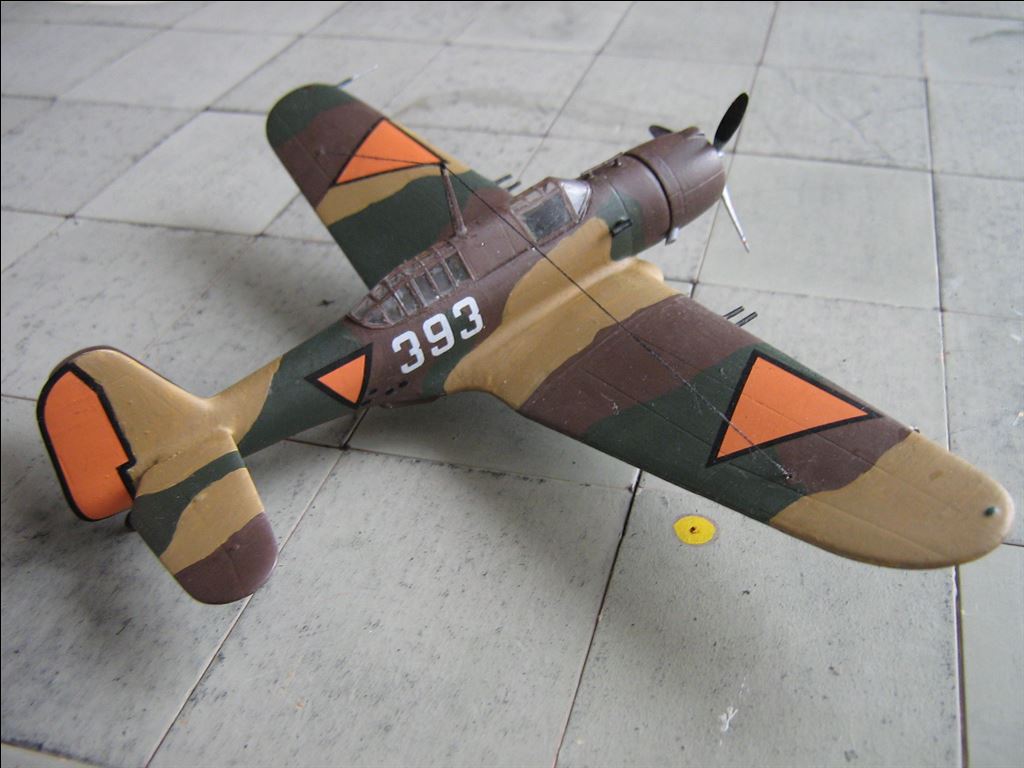
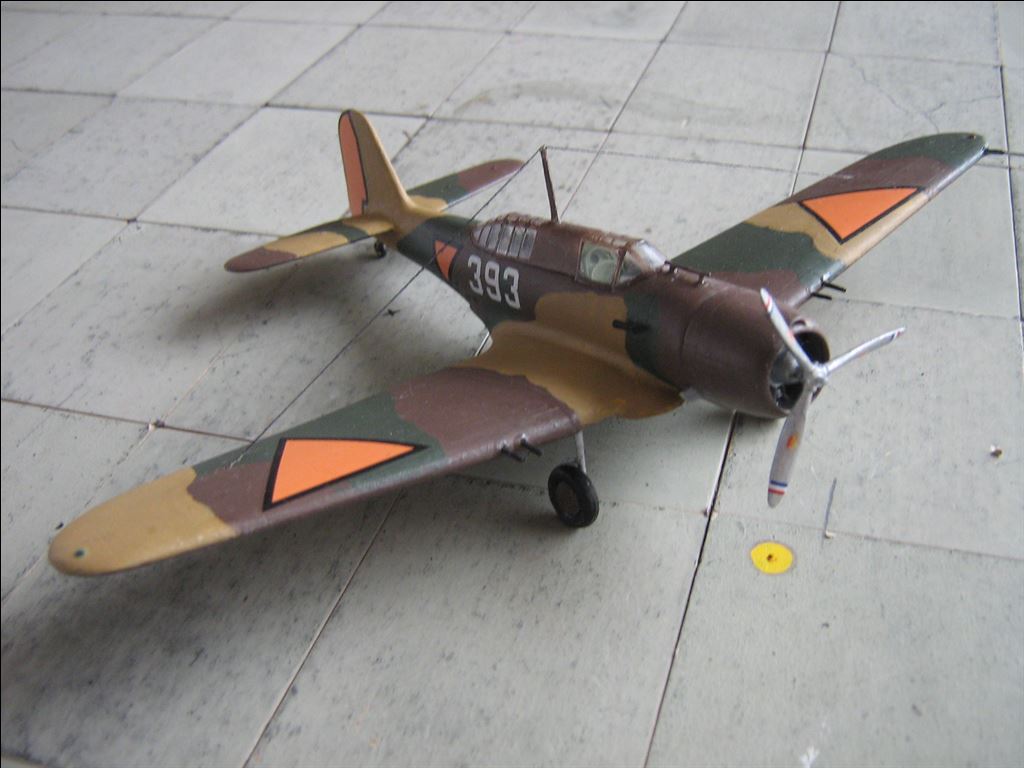
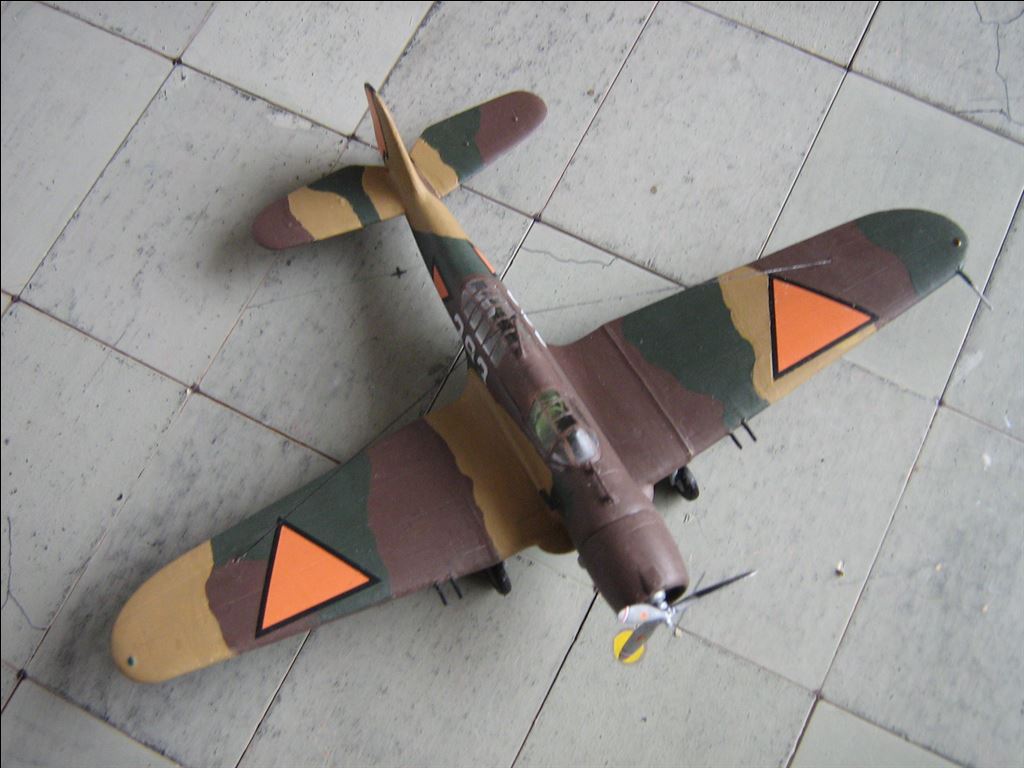
1/48th Scale
Kits
- Geromy
- Kit g48-004:Resin kit with white metal parts for a Douglas DB8A-3N. The kit contains Dutch decals
Modelling add-on
- --
- Kit --: --.
Decals
- --
- Kit --: ---.
| Scheme | Colour name | FS-number | Humbrol | XtraColor | WEM | Vallejo ModelColor | |
|---|---|---|---|---|---|---|---|
| Standard #1 | Upper surfaces | LVA Camouflage Brown | 20059 | - | - | AC D 02 | 70.985 |
| LVA Camouflage Beige | 26360 | ~168 | X16 | AC D 01 | |||
| LVA Camouflage Green | 24077 | ~172 | X223 | Ac D03 | 70.979 | ||
| Undersides | LVA Camouflage Brown | 20059 | - | - | AC D 02 | 70.985 | |
Check www.paint4models.com for an extensive conversion table with lots of colour and paint systems.
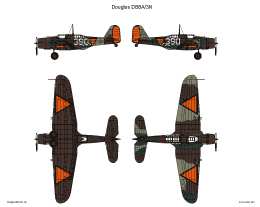
Literature.
| Nederlandse Militaire Luchtvaart in Beeld. deel 1. | Hugo Hooftman | pag. 146 - 147 | 1977 | Uitgever: Europese Bibliotheek, Zaltbommel |
| Modelbouw In Plastic jaargang 9, nummer 2: Naschrift 8A-3N artikel G.Wind MIP 1980-1. | Hans Loeber | pag. 45 | 1980 | Uitgever: I.P.M.S. Nederland, Nederland |
| Van Luchtvaartafdeling tot Koninklijke Luchtmacht 75 jaar Militaire Luchtvaart in Nederland | Koos van de Berg | 24 | 1987 | Uitgever: Rebo Produkties, Sassenheim |
| KLu Vliegtuigen: De vliegtuigen van de Koninklijke Luchtmacht vanaf 1913 | Wim Schoenmaker & Thijs Postma | pag. 70 | 1987 | Uitgeverij De Alk, Alkmaar |
| Luchtvaartwereld; 7e jaargang nummer 6: Douglas DB-8A/3N (deel 2) | Frits Gerdessen | pag. 187 - 190 | 1990 | Uitgeverij Ten Brink, Meppel |
| Luchtvaartwereld; 7e jaargang nummer 5: Douglas DB-8A/3N (deel 1) | Frits Gerdessen | Pag. 155 - 160 | 1990 | Uitgeverij Ten Brink, Meppel |
| Squadrons van de Koninklijke Luchtmacht (derde herzien druk) | Willem Helfferich | Pag. 17 - 19 | 1994 | Uitgevers Wyt, Rotterdam |
| Modelbouw in Plastic jaargang 24, nummer 2: Museumstukken van kunsthars deel 2 : Douglas 8A-3N | Peter Booy | Pag. 45 - 48 | 1995 | Uitgever: I.P.M.S. Nederland, Nederland |
| Camouflage en Kentekens | J.Greuter e.a. | 1997 | Bonneville – Bergen (NH) | |
| Dutch Profile: Douglas DB-8A/3N in dienst van de Militaire Luchtvaart | F. Gerdessen & L. Boerman | 2012 | Luukzwerk - Zwammerdam |
Websites.
--
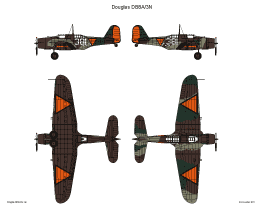
 Nederlands (nl-NL)
Nederlands (nl-NL)  English (United Kingdom)
English (United Kingdom)